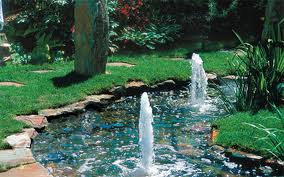





A suitable pump is fundamental to the success of any moving water feature. Particularly important is the flow rate it produces, for upon this depends the visual effect produced by the water’s movement.
 Whatever the type of pump you select, always choose a model that produces a flow rate that is greater than your present needs require; spare capacity will be invaluable if you want to modify the feature in the future.
Whatever the type of pump you select, always choose a model that produces a flow rate that is greater than your present needs require; spare capacity will be invaluable if you want to modify the feature in the future.
Modern domestic water gardens depend almost totally upon submersible pumps. These are excellent investments, being reliable, easily maintained and simple to install. They are placed on the floor of the pool and either fitted with a fountain spray outlet or a hose that feeds a waterfall or stream. Some larger-capacity pumps can be equipped with an adaptor that allows both fountain and waterfall to be supplied simultaneously.
The submersible pump is a self-contained sealed unit that draws in water through a filter and pushes it into the outlet pipe. The filter unit must be removed regularly so that the element can be washed to remove any debris it collects; a clogged filter will impair the pump’s operation.
The pump will be fitted with a waterproof cable, which will be long enough to reach well outside the pool. An armoured cable will be required to carry electricity from the house to the pool, the connection between this and the pump cable being made beneath a paving slab at the pool’s edge. This will not only protect the connection from the weather and accidental damage, but will also provide you with easy access.
Only when the pool is deeper than 90cm (36in), and a significant lift is needed for a fountain or waterfall, will problems arise with a submersible pump. In this situation, if a suitable pump cannot be obtained, it will have to be raised within the pool to reduce the depth of water above it.
Few domestic pool owners will want to use a surface pump. However, such a pump will be necessary for a fountain that shoots high jets of water, and for streams or waterfalls with large outputs.
They are also used by fish keepers who operate powerful filtration systems. A surface pump must be housed in a separate chamber constructed alongside the pool.
Ideally, the chamber should be situated below water level; if it is above water level, a foot valve and strainer must be fitted to the suction tube so that the pump remains primed when not running. In this situation, the vertical distance between the pump inlet and the water level must not exceed
Most modern submersible pumps have a small discharge, so it is important to have a clear idea of the quantity of water that you wish to move, then to shop around for a suitable pump. The majority will produce a satisfactory fountain, but a surprising amount of water is required for an effective waterfall. Most ready-made cascade units require an output of at least 1140 litres (250 gallons) per hour to put a thin sheet of water across their width, while 1365 litres (300 gallons) per hour are required to make a continuous filmy flow 15cm (6in) wide.
If you have any doubts about the required flow, a simple test can he employed to calculate the necessary capacity. Run water into the upper unit of the waterfall or stream from a hosepipe, and adjust the flow to produce the desired effect. Then collect the water that passes over the entire feature for a period of one minute. Measure the quantity collected, convert, it into litres or gallons and multiply that figure by 60. This will give you the amount of water that your pump will have to move in an hour. Check the flow rate chart for your chosen pump, making sure that the desired rate corresponds with the amount of lift that it will be required to achieve the suction lift capacity. If the chamber is constructed below water level, only an inlet strainer will be needed, as gravity will keep the pump primed.
The pump chamber must be dry. It need only be a modest brick structure, but an air brick should be incorporated to ensure ventilation, while a removable paving slab can be used for the roof.
The armoured cable that carries power to the pump must be controlled by a switch inside the house. The circuit must incorporate a residual current device, which will cut off the power automatically if the cable is damaged or a short circuit occurs. Since water and electricity do not mix, it is essential to seek the help of a qualified electrician.
The cable should be laid in a trench, at least 60cm (24in) deep, and buried in sand. Lay a warning tape over the cable before backfilling the trench with soil, to indicate the potential danger if someone digs in the area in the future. A simple map indicating the route of the cable should also be kept in a safe place. Connections to the pump cable must be made using weatherproof outdoor fittings.
Sonic small pumps operate on low-voltage power, provided by a transformer plugged into the domestic electricity supply. Unlike mains electricity, the current flow in a low-voltage system is not harmful, so the cable can be run on the surface, provided it is kept out of the way. It can be disguised by passing it among plants, but plastic conduit should be used to carry it under paths and other vulnerable areas. However, if any substantial water movement is required, a low-voltage pump is unlikely to have the necessary capacity, and a mains powered unit will be required.
Copyright © www.100flowers.win Botanic Garden All Rights Reserved